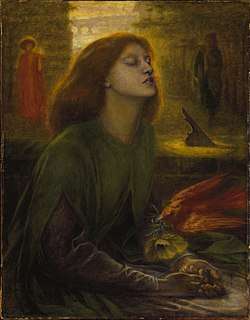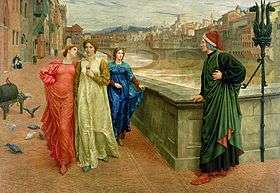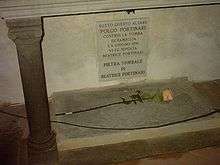Beatrice Portinari
Beatrice "Bice" di Folco Portinari[1] (Italian pronunciation: [be.aˈtriːtʃe], 1265 – 8 June 1290) was an Italian woman who has been commonly identified as the principal inspiration for Dante Alighieri's Vita Nuova, and is also commonly identified with the Beatrice who appears as one of his guides in the Divine Comedy (La Divina Commedia) in the last book, Paradiso, and in the last four canti of Purgatorio. There she takes over as guide from the Latin poet Virgil because, as a pagan, Virgil cannot enter Paradise and because, being the incarnation of beatific love, as her name implies, it is Beatrice who leads into the beatific vision. Just as Virgil represents human reason, so does Beatrice represent divine revelation,[2] theology, faith, contemplation and grace.[3]
Beatrice Portinari | |
|---|---|
 | |
| Born | Beatrice di Folco Portinari c.1265 |
| Died | 8 June 1290 (age 25) |
| Other names | Bice (nickname) |
| Known for | Inspiration for Dante Alighieri's Vita Nuova and Divine Comedy |
| Spouse(s) | Simone dei Bardi (m.1287) |
| Parent(s) | Father: Folco di Ricovero Portinari |
Scholars have long debated whether the historical Beatrice is intended to be identified with either or both of the Beatrices in Dante's writings. She was apparently the daughter of the banker Folco Portinari, and was married to another banker, Simone dei Bardi. Dante claims to have met a "Beatrice" only twice, on occasions separated by nine years, but was so affected by the meetings that he carried his love for her throughout his life.
Biography
Life
The tradition that identifies Bice di Folco Portinari as the Beatrice loved by Dante is now widely, though not unanimously, accepted by scholars. Boccaccio, in his commentary on the Divine Comedy, was the first one to explicitly refer to the young woman; all later references are dependent on his unsubstantiated identification. Clear documents on her life have always been scarce, helping to make even her existence doubtful. The only hard evidence is the will of Folco Portinari from 1287 which says "...item d. Bici filie sue et uxoris d. Simonis del Bardis reliquite ..., lib.50 ad floren"—essentially a bequest to his daughter who was married to Simone dei Bardi. Folco Portinari was a rich banker, born in Portico di Romagna. He moved to Florence and lived in a house near Dante where he had six daughters. Folco also gave generously to found the hospital of Santa Maria Nuova.
Beatrice and Dante
According to Dante, he first met Beatrice when his father took him to the Portinari house for a May Day party. They were both nine years old at the time, though Beatrice was a few months younger than Dante. Dante was instantly taken with her and remained so throughout his life even though she married another man, banker Simone dei Bardi, in 1287. Dante married Gemma Donati in 1285 and had children. Yet in spite of this, he maintained a deep love and respect for Beatrice, even after her death in 1290. After Beatrice's death, Dante withdrew into intense study and began composing poems dedicated to her memory. The collection of these poems, along with others he had previously written in his journal in awe of Beatrice, became La Vita Nuova.

According to the autobiographic La Vita Nuova, Beatrice and Dante met only twice during their lives. Even less credible is the numerology behind these encounters, marking out Dante's life in periods of nine years. This amount of time falls in line with Dante's repeated use of the number three or multiples of, derived from the Holy Trinity. It is more likely that the encounters with Beatrice that Dante writes of are the two that fulfill his poetic vision, and Beatrice, like Petrarch's Laura, seem to blur the line between an actual love interest and a means employed by the poet in his creations.
Following their first meeting, Dante was so enthralled by Beatrice that he later wrote in La Vita Nuova: Ecce Deus fortior me, qui veniens dominabitur michi ("Behold, a deity stronger than I; who coming, shall rule over me"). Indeed, Dante frequented parts of Florence, his home city, where he thought he might catch even a glimpse of her. As he did so, he made great efforts to ensure his thoughts of Beatrice remained private, even writing poetry for another lady, so as to use her as a "screen for the truth".
Dante's courtly love for Beatrice continued for nine years, before the pair finally met again. This meeting occurred in a street of Florence, which she walked along dressed in white and accompanied by two older women. She turned and greeted him, her salutation filling him with such joy that he retreated to his room to think about her. In doing so, he fell asleep, and had a dream which would become the subject of the first sonnet in La Vita Nuova.
In this dream, a mighty figure appeared before him, and spoke to him. Although he could not make out all the figure said, he managed to hear "Ego dominus tuus", which means "I am your Lord". In the figure's arms was Beatrice, sleeping and covered by a crimson cloth. The figure woke Beatrice, and made her eat Dante's burning heart. An English translation of this event, as described in La Vita Nuova, appears below:
And betaking me to the loneliness of mine own room, I fell to thinking of this most courteous lady, thinking of whom I was overtaken by a pleasant slumber, wherein a marvelous vision was presented to me: for there appeared to be in my room a mist of the colour of fire, within the which I discerned the figure of a Lord of terrible aspect to such as should gaze upon him, but who seemed there-withal to rejoice inwardly that it was a marvel to see. Speaking he said many things, among the which I could understand but few; and of these, this: "I am thy Lord". In his arms it seemed to me that a person was sleeping, covered only with a crimson cloth; upon whom looking very attentively, I knew that it was the Lady of the Salutation, who had deigned the day before to salute me. And he who held her held also in his hand a thing that was burning in flames, and he said to me "Behold thy heart". But when he had remained with me a little while, I thought that he set himself to awaken her that slept; after the which he made her to eat that thing which flamed in his hand; and she ate as one fearing.[4]
This was the last encounter between the pair, since Beatrice died eight years later at the age of twenty-five in 1290.

The manner in which Dante chose to express his love for Beatrice often agreed with the Middle Ages concept of courtly love. Courtly love was very formal; a sometimes secret, often unrequited and highly respectful form of admiration for another person. Yet it is still not entirely clear what caused Dante to fall in love with Beatrice. Since he knew very little of the real Beatrice, and that he had no great insight to her character, it is perhaps unusual that he did. But he did, and there are clues in his works as to why:
She has ineffable courtesy, is my beatitude, the destroyer of all vices and the queen of virtue, salvation.
Dante saw Beatrice as a saviour, one who removed all evil intentions from him. It is perhaps this idea of her being a force for good that he fell in love with, a force which he believed made him a better person. This is certainly viable, since he does not seem concerned with her appearance—at least not in his writings. He only once describes her complexion, and her "emerald" eyes.
Influence on Dante's work
.jpg)
Beatrice's influence was far from simple inspiration. According to Dante, he first met Beatrice when his father took him to the Portinari house for a May Day party. They were both nine years old at the time, though Beatrice was a few months younger than Dante. She appeared as a character in his two greatest works—La Vita Nuova and Divine Comedy.
She first appeared in the autobiographical text, La Vita Nuova, which Dante wrote in about 1293. The book was filled with poems and also prose that is autoethnographical in form as it connects the poems to Beatrice to his social and romantic reality. The writing is almost entirely complimentary to her; she was described as "gentilissima" and "benedetta" (meaning "most kind" and "blessed" respectively).
Having already referred to Beatrice as his salvation, this idea is further touched upon in Divine Comedy, where she appears as a guide through Heaven who caused his trip through the afterlife so he might see what awaits him. Here she is described as being "maternal, radiant and comforting".
Although they converse in personal terms, very rarely did their relationship extend beyond a casual street ceremony. However, upon invitation of a friend, Dante was in attendance at a customary event where maids of honor support a new bride during her first meal with the groom, and Beatrice, along with other maids of honor, were in attendance. Dante prior to seeing Beatrice asked his friend, "Why have we come here to these women?” He said, “To make sure they’re properly attended to” (La Vita Nuova in digitaldante, 2012). Dante recounts this experience in La Vita Nuova by noting:
"No sooner did I make this suggestion than I thought I sensed the appearance of a marvelous trembling that started on the left side of my chest and spread rapidly throughout my entire body. Then I had to prop myself, surreptitiously, against one of the pictures that ran around the walls of this house; and fearing that someone might have noticed my shaking, I raised my eyes, and looking around at the women, among them I saw that most gracious of creatures, Beatrice." [5]
Dante believed that some of the other women and Beatrice were "making fun" of his physical state and so he wrote a sonnet, present in La Vita Nuova, that begins, “With other women” (La Vita Nuova in digitaldante, 2012).
Any romantic exchange between Dante and Beatrice in The Divine Comedy is no more than the imagination of Dante.
In popular culture
Beatrice Portinari has been immortalized not only in Dante's poems but in paintings by Pre-Raphaelite masters and poets in the nineteenth century.
Subjects taken from Dante Alighieri's La Vita Nuova (which Rossetti had translated into English) and mostly the idealisation of Beatrice Portinari had inspired a great deal of Dante Gabriel Rossetti's art in the 1850s, in particular after the death of his wife Elizabeth Siddal. He idealised her image as Dante's Beatrice in a number of paintings, such as Beata Beatrix.
Beatrice has also been immortalised in space, as asteroid 83 Beatrix is named in her honour.[6]
The Dante Alighieri Academy Beatrice Campus, a Catholic high school in Toronto, Ontario, Canada is named after Portinari.
In A Series of Unfortunate Events by Lemony Snicket, Snicket's love interest is named Beatrice, after Portinari. The relationship between the characters is very similar to that of Beatrice and Dante.
In the animated miniseries Over the Garden Wall the woods called the Unknown is implied multiple times throughout the series to be some form of afterlife. Here, the main characters Wirt and Greg are guided through the Unknown by a bluebird named Beatrice.
References
- "Dante Alighieri on the Web". Greatdante.net. Archived from the original on 2013-08-30. Retrieved 2013-09-04.
- Lansing, Richard. The Dante Encyvlopedia. p. 743.
- Lansing, Richard. The Dante Encyclopedia. p. 93.
- , Dante Alighieri, "La Vita Nuova," as translated by Dante Gabriel Rossetti via The Project Gutenberg ebook.
- Alighieri, Dante. "La Vita Nuova". digitaldante.columbia.edu. Northwestern UP. Retrieved 30 December 2018.
- Schmadel, Lutz D. (2013). Dictionary of Minor Planet Names. Springer Science & Business Media. p. 31. ISBN 9783662066157.
Further reading
- Conway, James. "Beatrice and Other Allegorical Characters of Dante Alighieri," The American Catholic Quarterly Review, Vol. XVII, 1892.
- Frisardi, Andrew. The Young Dante and the One Love: Two Lectures on the Vita Nova. Temenos Academy, 2013. ISBN 978-0-9564078-8-7.